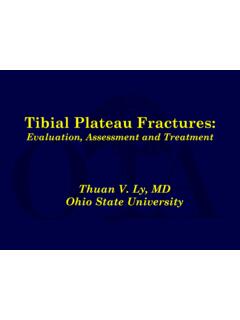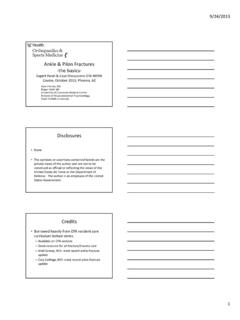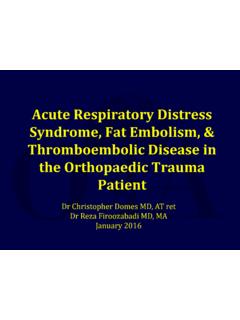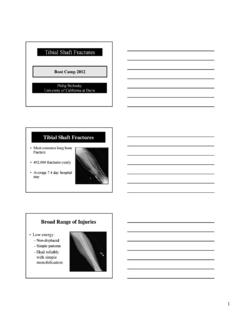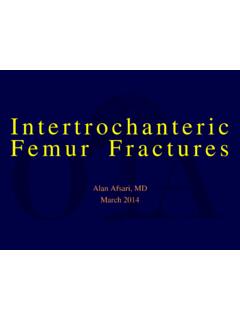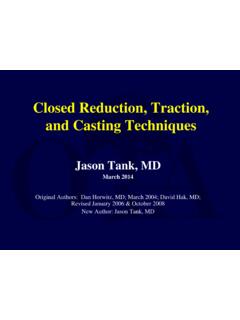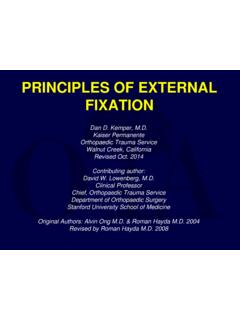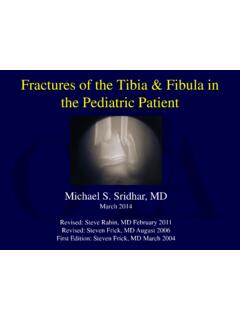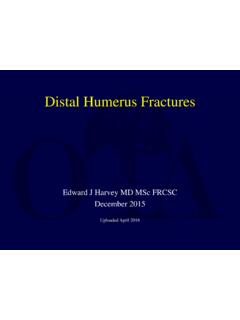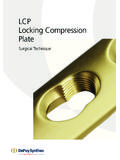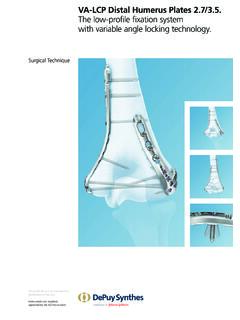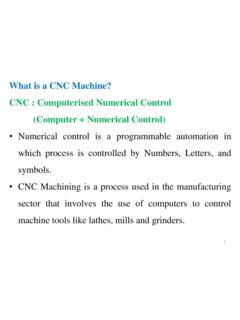Transcription of Basic Principles and Techniques of Internal Fixation of ...
1 Basic Principles and Techniques of Internal Fixation of Fractures Leo A. Calafi, MD March 2014 1 Overview Types of Bone healing and Fixation constructs Types and functions of Internal Fixation Summary 2 Biology of Bone Healing Primary Bone Healing Requires direct reduction and absolute stability Requires increased fracture stability and a low strain ( 2%) environment Harvesian remodeling No callus Secondary Bone Healing Requires indirect reduction and relative stability Requires a high strain ( 2%) fracture environment Enchondral/intramembranous ossification Callus/cartilage become mineralized and replaced by bone 3 Fixation Construct Fracture personality and patient factors determine Fixation construct Fracture personality encompasses factors such as anatomic location, fracture pattern, bone quality, and soft tissue status Simple fracture patterns and articular injuries are treated with direct reduction and absolute stability Complex and comminuted fracture patterns are treated with indirect reduction and relative stability 4 Fracture Stability Absolute stability Involves direct visualization, anatomic reduction, and stable Fixation Lag screws.
2 compression plating Relative stability Involves indirect reduction and Fixation The goal is restoration of axial, angular, and rotational alignment, while preserving the biological environment of the fracture IM rods, bridge plating, Ex-fix, casting 5 Absolute (Rigid/No Callus) Relative (Flexible/Callus) Spectrum of Stability Cast IM Nail compression Plating/Lag Screw Ex-Fix Bridge Plating In reality, most fixations involve components of both types of healing 6 Absolute Stability 7 Relative Stability 8 Hybrid Fixation This type of Fixation involves a combination of absolute and relative stability Principles An example would be a peri-articular fracture with extensive meta-diaphyseal comminution Direct reduction and absolute stability for the articular block.
3 Bridge plating and relative stability for the meta-diaphysis 9 Goals and Indications for Internal Fixation Goals: Restoration of bony anatomy while respecting soft tissues Stable Fixation Accelerated recovery More predictable and potentially faster healing Indications: Displaced intra-articular fractures Open fracture Polytrauma Associated neurovascular injury Failure of closed treatment 10 Fixation Functions Lag Screw Inter-fragmentary compression Plates Neutralization Buttress/anti-glide Tension Band compression Bridge locking Intramedullary Nails Internal splint Bridge plate Fixation Internal splint External Fixation External splint Cast External splint 11 Screw Types Cancellous Cortical Solid vs.
4 Cannulated locking vs. non- locking locking screw head locks into the plate creating a fixed angle device; can be cortical, cancellous, solid, or cannulated 12 Figure from Rockwood & Green s Fractures in Adults, 6th Edition 13 Conventional vs. locking Screw Tightening of the screw compresses the plate to the bone and the resulting friction forces keep the construct stable The screw head threads and locks into the plate creating an angular- stable construct Copyright by AO Foundation, Switzerland 14 Screw Functions Positional screw screw has a neutral effect on fracture fragment position, pilot hole diameter is slightly greater than screw core diameter plate screw can be locking or non- locking head; non- locking produces friction between plate and bone due to compression ; locking provides angular stability Poller/blocking screw used to redirect an IMN Lag screw Inter-fragmentary compression .
5 Both fully threaded and partially threaded screws can have a lag effect 15 Lag Screw Lag by technique Fully threaded screws act as a lag screw when the proximal hole (gliding hole) is drilled with the diameter of the screw thread Lag by design Partially threaded screws can act as a lag screw as long as the threaded part does not cross the fracture line Copyright by AO Foundation, Switzerland 16 Lag Screw Technique Fully threaded (example: cortex screw) the fracture and drill perpendicular to the obliquity of the fracture line hole Drilling with the outer diameter of the screw ( ) should only be done to the fracture line the drill for the core diameter of the screw ( ) within the gliding hole using a drill sleeve and drill the far cortex of the proximal cortex improves screw-bone load transfer (measure screw length after countersinking)
6 17 Malposition of the screw, not counter-sinking, or fracture comminution can lead to loss of reduction 18 Copyright by AO Foundation A lag screw inserted perpendicular to the long axis of bone results in maximal resistance to shear forces produced during axial loading A lag screw placed perpendicular to the fracture line results in maximum inter-fragmentary compression Figures from Rockwood & Green s Fractures in Adults, 6th Edition 19 In most cases, a single lag screw is not sufficient to stabilize the forces within the fracture, especially shear and rotational forces, therefore additional lag screw(s) and/or a neutralization plate may be required 20 Copyright by AO Foundation, Switzerland plate Function: Neutralization Neutralizes/protects lag screws from shear, bending, or torsional forces across the fracture Can be a locking or a non- locking plate Neutralization plate Lag screw Figure from Rockwood & Green s Fractures in Adults, 6th Edition 21 plate Function: Buttress/Anti-glide Buttress plate When applied to metaphyseal fractures to support intra-articular fragments If a stiff plate is used, exact contouring to the local anatomy is necessary.
7 Alternatively, pre-contoured anatomical plates can be used Anti-glide plate When applied to diaphyseal fractures The anti-glide effect leads to compression within the fracture with axial loading Both neutralize vertical shear forces during axial loading Practically speaking, they prevent sliding/shortening of the fracture fragments 23 Buttress plate Anti-glide plate Figure from Rockwood & Green s Fractures in Adults, 6th Edition Copyright by AO Foundation, Switzerland 23 A buttress effect can also be obtained with a strategically placed screw and washer at the apex of the fracture 24 Copyright by AO Foundation, Switzerland Plates can be used with or without lag screws to provide buttress If plates with DC holes are used, the screw should be inserted in buttress position to prevent plate sliding plate prevents sliding of the proximal fragment with axial loading 25 Copyright by AO Foundation, Switzerland plate Function: Tension Band Principle.
8 Tensile forces are converted into compression forces The plate must be applied to the tension (convex) side of the bone With loading, the plate will be under tension, thereby compressing the fracture Copyright by AO Foundation, Switzerland 26 In certain articular fractures ( patella, olecranon) where muscle forces during motion tend to distract fracture fragments, the application of a tension band will convert distracting forces into compressive forces with flexion For ideal tension band effect, the fracture has to be simple and oriented relatively perpendicular to the line of motion This principle also applies to avulsion fractures that occur at the insertion of tendons or ligaments ( greater tuberosity of humerus, medial malleolus, etc.)
9 Copyright by AO Foundation, Switzerland 27 plate Function: compression compression provides rigid Fixation and absolute stability Especially helpful in transverse fractures, where a lag screw placement is not possible compression plating can be accomplished by: plate design (dynamic compression principle) Over-bending of the plate External tension device Combination of the above Can be used alone or in combination with lag screws: Alone In transverse or short oblique fractures where lag screw placement is difficult In combination: compress with the plate prior to lag screw placement 28 compression : plate Design The screw holes of the plate have an inclination; as the screw is tightened, the head slides down this inclination, thereby compressing the fracture This concept is predicated on eccentric ( away from fracture) screw placement within the oval plate hole, as well as, anchoring the plate first with another screw on the opposite side of the fracture DCP, LC-DCP, 1/3 tubular, and reconstruction plates can all compress, but the effect is best with DCP and LC-DCP compression : plate Design Eccentric drilling away from fracture First, affix the plate , ideally with a screw in neutral position, on the opposite side Inclination Figures from Rockwood & Green s Fractures in Adults, 6th Edition 30 compression .
10 plate Bending Without pre-bending the plate , there will be compression under the plate and distraction on the opposite cortex Pre-bending results in evenly distributed forces across the fracture site Figure from Rockwood & Green s Fractures in Adults, 6th Edition 31 compression : Tension Device compression of an oblique fracture must be performed in such a way that the loose fracture fragment locks in the axilla of the plate -bone construct, otherwise, it will lead to mal-reduction plate axilla is here in this fracture obliquity Copyright by AO Foundation, Switzerland 32 When a lag screw is placed through a compression plate , compress with the plate first prior to lag screw placement Figure from Rockwood & Green s Fractures in Adults, 5th Edition 33 plate Function: Bridge This technique is suited for highly comminuted metaphyseal or diaphyseal fractures or situations where the overlying soft tissues preclude a direct approach to the fracture The goal is.
